Eta Carinae - Our Local Superstar
Introducing Eta Carinae
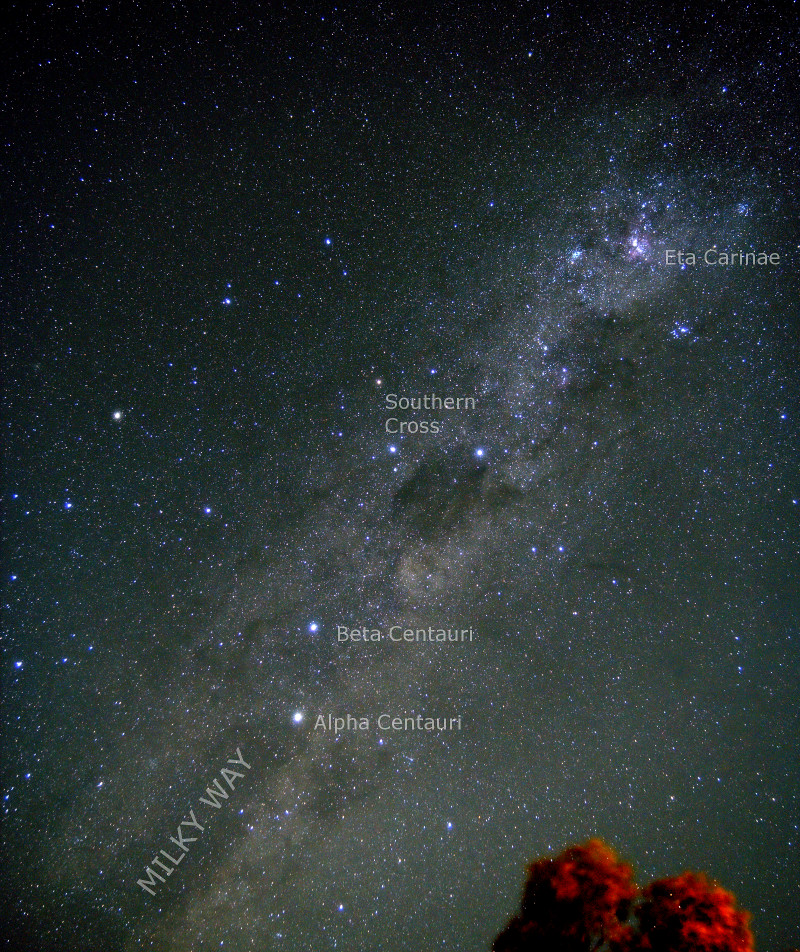
The Southern milky way with the Eta Carinae and Southern Cross are shown rising in the Southeast in this view not too dissimilar to the naked eye view from a dark rural location. Credit: Author
One of the most familiar objects in the night sky for southern hemisphere people is Eta Carinae. It doesn’t look too much to the naked eye, appearing like a brightish knot or smudge in the Milky way not far from the Southern Cross. But it is our nearest “Superstar”. When I mean Superstar, I’m obviously not talking about Hollywood, but an actual star so large it can barely stop itself from blowing itself apart. In fact for a few years in the 1840’s, it nearly did just that, hurling 30% of its mass into space and becoming almost the brightest star in the night sky in the process.
Eta Carinae is a binary star, with primary and secondary components estimated at 100 and 20 times the mass of the sun respectively. At a distance of 7500 light years, it is one of the most distant naked eye stars. The sun at that distance would be at least 10,000 times too faint to be seen with the naked eye (even from the darkest skies).
In this article, I will examine some of the more interesting facts about the star Eta Carinae and its environs.
From a Distance
The region around Eta Carinae is strewn with stars and nebula as seen in binoculars or a small telescope. The Nebula is often called the Eta Carinae Nebula, or the Carina Nebula and sometimes NGC 3372. NGC3372 means it was the 3372nd entry in the New General Catalog. Unfortunately, human vision cannot detect color in the main nebula because of the low light levels but photographically the reds and blues caused by Hydrogen emission are plainly visible.
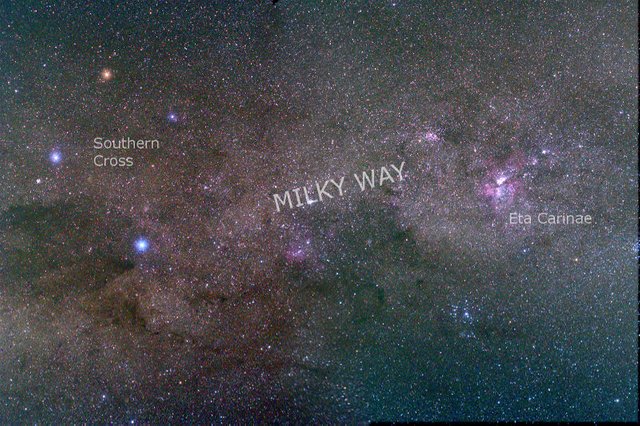
This is a closer view of Eta Carinae and the Southern Cross, and stars to reveal that Eta Carinae is involved with a reddish emission nebula and a star cluster. Credit: Author
Eta Carinae Nebula and Trumpler 16
With increasingly larger telescopes and photographic lenses, the nebula begins to reveal itself as a complex (mostly) emission nebula. Embedded in the nebula is a massive star cluster Trumpler 16 that includes some of the largest and most brilliant stars known (including Eta Carinae and WR25). In the following image, the nebula shines beautiful shades of red and pink caused by Hydrogen emission, with areas of interstellar dust causing voids and reddening of the nebula. The Star Eta Carinae itself lies in the brightest section of the nebula.
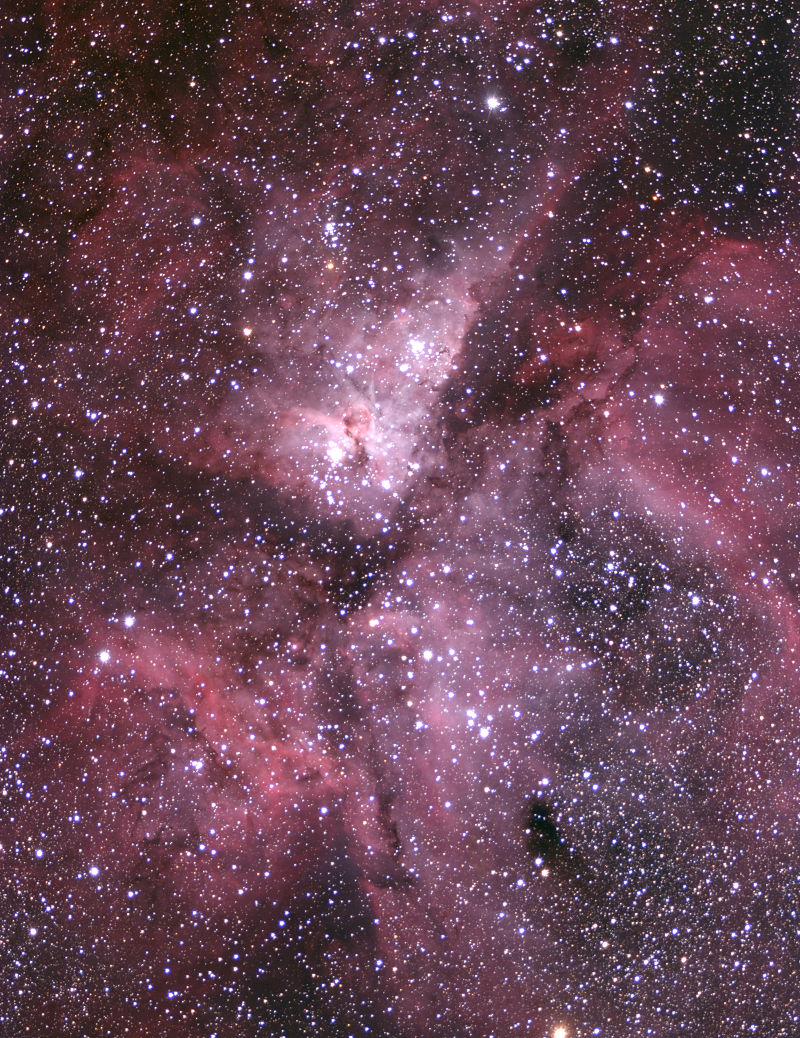
At a focal length of 425mm, Eta Carinae is shown to be embedded in a spectacular emission nebula (NGC3372), with an embedded star cluster containing some of the most massive and luminous stars in the galaxy, Including the star Eta Carinae itself and WR25. Credit: Author
The Homunculus Nebula
Zooming in on the star Eta Carinae at decent magnification reveals a small pinkish shell around the star that has been dubbed the Homunculus Nebula. It is actually bright enough to show color when seen directly by eye in a telescope. Observations of this shell by the Hubble telescope show that it is expanding at a rate consistent with it being released around the time when Eta Carinae flared in brightness in 1845 (see below).
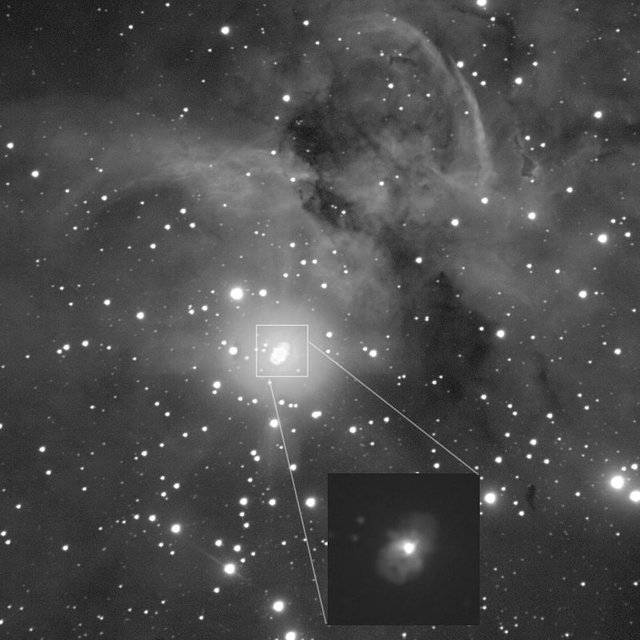
At a focal length of 2700mm, Eta Carinae (the brightest object in this image) can be seen to be visibly oval which is a hint of the cocoon of matter that surrounds the star called the Homunculus nebula. The insert used shorter exposures and a longer focal length to reveal some structure in the Homunculus nebula. The large bubble-like structure to the right is sometimes called the "Keyhole". Credit: Author
The structure of the Homunculus nebula as seen by the Hubble Telescope is quite spectacular and reveals a bi-lobed structure probably a result of ejection from the poles of the primary star. Eta Carinae is heavily obscured by the nebula so that much of the light from the star is absorbed and re-emitted in infrared. Below is a typical Hubble image of the Homunculus.
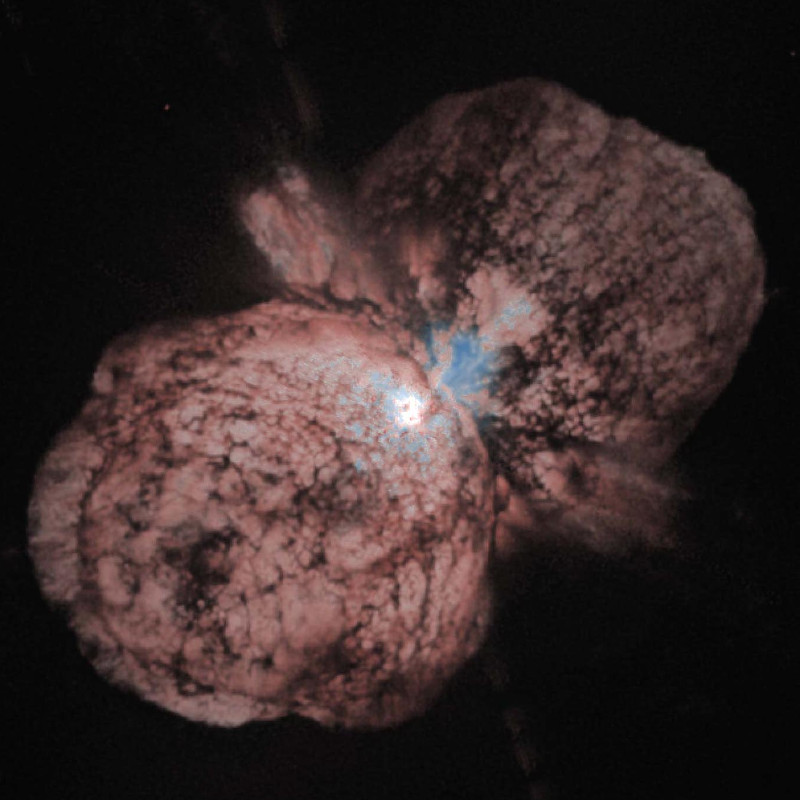
Hubble closeup of the Homunculus Nebula. Image Credit: NASA/ESA
Recently, a 3D model of the Homunculus was mapped out using by using Doppler measurements across the nebula combined with assumptions based on the expansion vectors at various points. The dipole structure appears to be aligned with the perpendicular line from the orbital plane of the secondary star around the primary star. The mechanism that triggered the 1845 original eruption of Eta Carinae is not known.
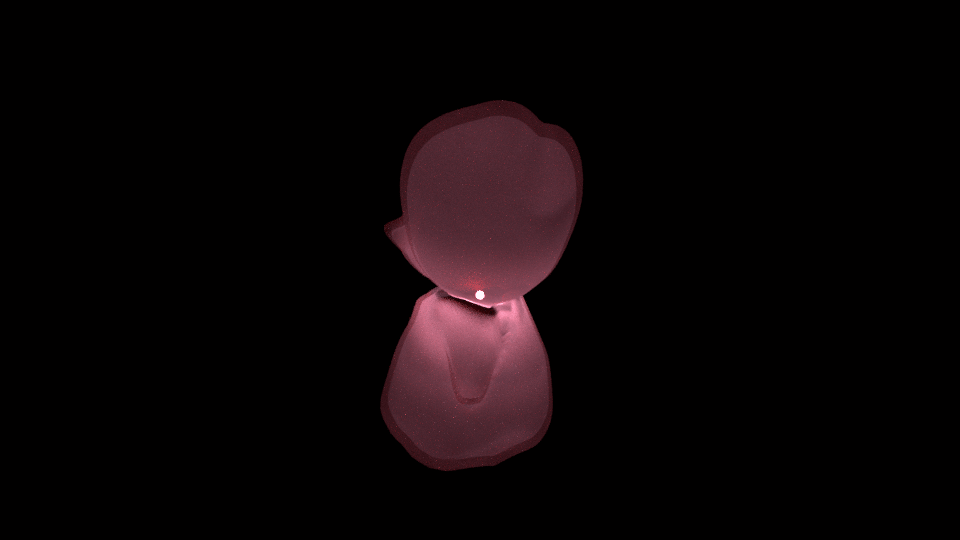
Simple Animation showing the simulated development of the Homunculus nebula from the point of formation in the 1840's. 3D model data Credit: NASA/Steffen, W., Teodoro, M., Madura, T., et al. (2014). Animation Credit: Author
The Eta Carinae Binary System
Eta Carinae was first noted in 1677 by none other than Edmond Halley. The star appears to have started brightening sometime in the 1700's, and by 1837 was being recorded a bright star. The brightening continued into 1845 when for a few days it became the second brightest star in the nighttime star. This brightening was followed by a steady decline to below naked-eye visibility, a level which it remained at until around 1950. There was also a minor outburst around 1892, although it didn't become very bright.
After 1950, the star began to slowly brighten which is a trend that continues to this day. The brightening trend has been to double in brightness every 20 years. In recent times, at least from a dark sky, it has become visible to the naked eye. The diagram below shows the star's brightness from 1600 until the present time. Note that astronomers use the term "magnitude" to describe the apparent brightness of objects in the sky, a further description of magnitude can be found here .
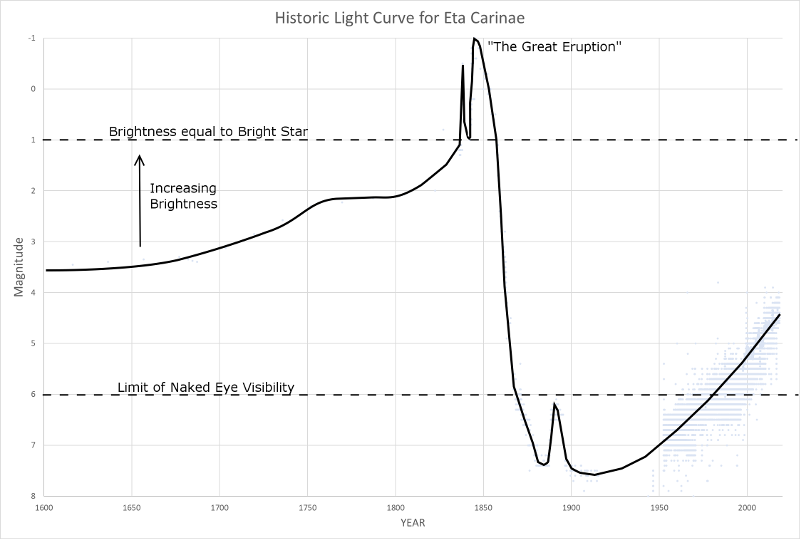
Historic Light curve of Eta Carina from 1600 all the way through to 2018 (generated from variable star observations from the AAVSO International Database contributed by observers worldwide)
As was mentioned earlier the cause of the great eruption of 1845 is not understood, however, the primary star is believed to be an LBV (Luminous Blue Variable) with a mass estimated to be a hundred times greater than the sun. Other LBV stars have also been observed to erupt in brightness similar to Eta Carinae.
The mass of the primary star is estimated around 100 solar masses although before the 1845 eruption it was likely closer to 130-140 solar masses. This puts it among the most massive stars ever found. Because the star is heavily obscured by gas and dust it's true visual brightness will likely be in the range of 100,000-1,000,000 times that of the sun, and the actual energy output may approach 5,000,000 times that of the sun!
Unlike a normal sun-like star, Eta Carinae's primary emits an extremely dense stellar wind which results in it losing one solar mass per 1000 years. The stellar wind is so dense that star does not have a well-defined edge like the sun. In comparison, the smaller companion star, at a 20 solar masses ejects mass at a rate about 10 times less than the primary star. The secondary star gets quite close to the primary every 5.5 years, about the distance of mars.
Recent computer modeling revealed some interesting insights into how the stellar winds interact between the primary and secondary stars. The animation below shows how the higher speed secondary stellar wind collides with slower, but denser primary wind. The secondary star's stellar wind pushes apart the dense primary stellar wind as approaches and retreats from the primary star. A shock boundary forms between the two winds which is sufficiently energetic to heat the gases and generate X-Ray emission. However, during the secondary stars close approach to the primary star its change in orbital vector causes a break in the shock boundary, resulting in a collapse in X-Ray emissions. Observational data does indeed show this behavior.
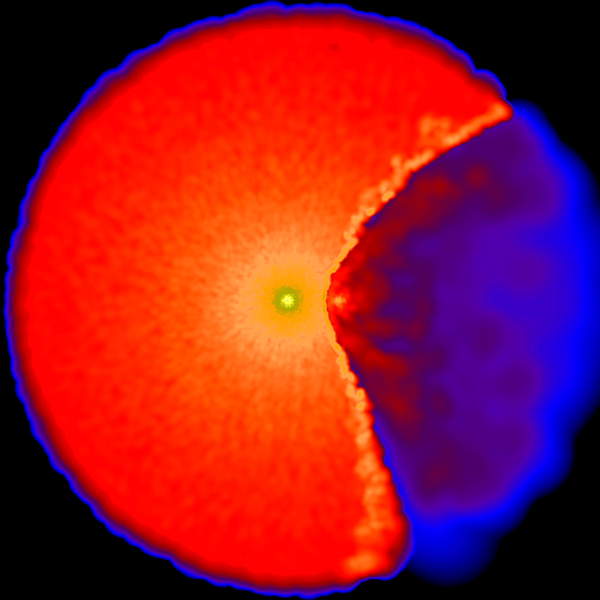
*Stellar winds interact as the secondary star orbits around the primary star. Credit: NASA's Goddard Space Flight Center/T. Madura. *
The future for Eta Carinae is uncertain, but it is very likely to end its life as a supernova. It is also likely to do this in a relatively short span of time (less than 50,000 years).
Conclusions
Something incredible is happening to Eta Carinae, having shed 30 suns worth of mass over a couple years around 1845. What will it do next? Some think it may go supernova in the near future and be visible as a brilliant star in the night sky.
References
NASA Missions Take an Unparalleled Look into Superstar Eta Carinae
Morse, Jon A., James R. Kellogg, John Bally, Kris Davidson, Bruce Balick, and Dennis Ebbets. "[ITAL]Hubble Space Telescope[/ITAL] Proper-Motion Measurements of the η Carinae Nebula." The Astrophysical Journal 548, no. 2 (2001). doi:10.1086/319092.
Steffen, W., M. Teodoro, T. I. Madura, J. H. Groh, T. R. Gull, A. Mehner, M. F. Corcoran, A. Damineli, and K. Hamaguchi. "The Three-dimensional Structure of the Eta Carinae Homunculus." Monthly Notices of the Royal Astronomical Society 442, no. 4 (2014): 3316-328. doi:10.1093/mnras/stu1088.


A beautiful biography of a superstar!
This makes me want to be in the Southern Hemisphere so I can look for it now.
Another fascinating post as usual, Terry.
Thanks Choo!
Technically you could see Eta Carinae because of your latitude. But you have to get well away from the city lights to have any chance.
Hmm, that's unlikely. But good to know.
Hey @terrylovejoy, that was another wonderful blog!
I was amazed once again by your spectacular shots! Those images of yours are pure gold!
I really can't wrap my brain around this. The magnitude is just enormous.
Thank you for your amazing contributions!
Keep up the awesome work!
Thank you @lordneroo !
Hey , awesome post man. The Carina Nebula is one of my favourites to try and get a good shot of (now that I'm in the Southern Hemisphere anyway :) ) I hadn't really researched that much into it , so this was definitely a good read. I especially found that part about the stellar winds and the dual stars quite interesting.
Cool man .. thanks for this post :)
Its very easy to see in a telescope, and makes a good photographic subject. If you have a telescope try to see the homunculus nebula, it is one of the few objects bright enough to show distinct color in the night sky.
Hey Terry , thanks for the reply. I haven't actually looked through a telescope with my eyes in a good long while now. I've been into astrophotography for a good few years now , although I haven't clocked up that many hours , so really I'm just starting.
I've only just got my mount up and running again , as my controller bit the dust a while back, and now I've set up an old computer to control it , my camera and hopefully get some guided images this time :)
Pretty much all of my previous shots were single shots(no stacking) and unguided , so some success , some not :) . But yeah , I have gotten a few good shots of the Carina Nebula so far , actually the first thing I did after reading your reply was go back to some of my shots and look for the homunculus nebula , and sure enough there it was , tiny , but there. I hadn't even realized that was there before you mentioned it ... so thanks for that :) And I'll have to check with my eyes when I get out there again.
Great to hear @betelzeus. Some of these objects have traditionally gone unnoticed as the majority of guides/books have been written with a northern hemisphere bias. The first time I was shown the Homunculus nebula through a telescope I had been into astronomy for about 10 years and had no idea it existed. It was one of those things that goes unnoticed unless your looking for it.
It's hard to find adequate words to describe the incredible events which happened both centuries ago and are happening even now in our universe @terrylovejoy Many thanks for revealing a few of the mysteries of this vast and sometimes unfathomable world. (U & R )
Thank you as always Trudee !
You're very welcome Terry.
thirty suns? i can't wrap my head around that.
Yes in the space of about 10 years it threw that much material into space
Congratulations, your post has been selected for TecNews! Thank you for your contribution!
That Hubble close up is amazing. We live in such a cool age where all this info and imagery is so available.
It is quite incredible, I agree!
Hi, I found some acronyms/abbreviations in this post. This is how they expand:
good post